Identification of Core Genes Related to Progression and Prognosis of Hepatocellular Carcinoma and Small-Molecule Drug Predication
- PMID: 33708237
- PMCID: PMC7940693
- DOI: 10.3389/fgene.2021.608017
Identification of Core Genes Related to Progression and Prognosis of Hepatocellular Carcinoma and Small-Molecule Drug Predication
Abstract
Background: Hepatocellular carcinoma (HCC) is one of the most leading causes of cancer death with a poor prognosis. However, the underlying molecular mechanisms are largely unclear, and effective treatment for it is limited. Using an integrated bioinformatics method, the present study aimed to identify the key candidate prognostic genes that are involved in HCC development and identify small-molecule drugs with treatment potential.
Methods and results: In this study, by using three expression profile datasets from Gene Expression Omnibus database, 1,704 differentially expressed genes were identified, including 671 upregulated and 1,033 downregulated genes. Then, weighted co-expression network analysis revealed nine modules are related with pathological stage; turquoise module was the most associated module. Gene Ontology (GO) and Kyoto Encyclopedia of Genes and Genomes pathway analyses (KEGG) indicated that these genes were enriched in cell division, cell cycle, and metabolic related pathways. Furthermore, by analyzing the turquoise module, 22 genes were identified as hub genes. Based on HCC data from gene expression profiling interactive analysis (GEPIA) database, nine genes associated with progression and prognosis of HCC were screened, including ANLN, BIRC5, BUB1B, CDC20, CDCA5, CDK1, NCAPG, NEK2, and TOP2A. According to the Human Protein Atlas and the Oncomine database, these genes were highly upregulated in HCC tumor samples. Moreover, multivariate Cox regression analysis showed that the risk score based on the gene expression signature of these nine genes was an independent prognostic factor for overall survival and disease-free survival in HCC patients. In addition, the candidate small-molecule drugs for HCC were identified by the CMap database.
Conclusion: In conclusion, the nine key gene signatures related to HCC progression and prognosis were identified and validated. The cell cycle pathway was the core pathway enriched with these key genes. Moreover, several candidate molecule drugs were identified, providing insights into novel therapeutic approaches for HCC.
Keywords: hepatocellular carcinoma; multivariate cox; prognosis; risk score; weighted gene co-expression network analysis.
Copyright © 2021 Jiang, Zhang, Qin, Yang, Wu, Wang, Sun, Li, Shen, Lin, Kantawong and Wu.
Conflict of interest statement
The authors declare that the research was conducted in the absence of any commercial or financial relationships that could be construed as a potential conflict of interest.
Figures



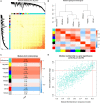
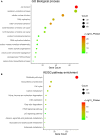

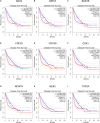
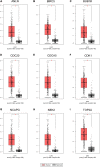

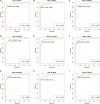


Similar articles
-
Screening Hub Genes as Prognostic Biomarkers of Hepatocellular Carcinoma by Bioinformatics Analysis.Cell Transplant. 2019 Dec;28(1_suppl):76S-86S. doi: 10.1177/0963689719893950. Epub 2019 Dec 11. Cell Transplant. 2019. PMID: 31822116 Free PMC article.
-
Identification and Analysis of Potential Key Genes Associated With Hepatocellular Carcinoma Based on Integrated Bioinformatics Methods.Front Genet. 2021 Mar 9;12:571231. doi: 10.3389/fgene.2021.571231. eCollection 2021. Front Genet. 2021. PMID: 33767726 Free PMC article.
-
Bioinformatics Analysis of Candidate Genes and Pathways Related to Hepatocellular Carcinoma in China: A Study Based on Public Databases.Pathol Oncol Res. 2021 Mar 26;27:588532. doi: 10.3389/pore.2021.588532. eCollection 2021. Pathol Oncol Res. 2021. PMID: 34257537 Free PMC article.
-
Identification of 40S ribosomal protein S8 as a novel biomarker for alcohol‑associated hepatocellular carcinoma using weighted gene co‑expression network analysis.Oncol Rep. 2020 Aug;44(2):611-627. doi: 10.3892/or.2020.7634. Epub 2020 Jun 5. Oncol Rep. 2020. PMID: 32627011 Free PMC article.
-
Identification of significant gene and pathways involved in HBV-related hepatocellular carcinoma by bioinformatics analysis.PeerJ. 2019 Jul 30;7:e7408. doi: 10.7717/peerj.7408. eCollection 2019. PeerJ. 2019. PMID: 31392101 Free PMC article.
Cited by
-
Potential Prognostic Biomarkers of NIMA (Never in Mitosis, Gene A)-Related Kinase (NEK) Family Members in Breast Cancer.J Pers Med. 2021 Oct 26;11(11):1089. doi: 10.3390/jpm11111089. J Pers Med. 2021. PMID: 34834441 Free PMC article.
-
Prognostic Implication of a Novel Metabolism-Related Gene Signature in Hepatocellular Carcinoma.Front Oncol. 2021 Jun 4;11:666199. doi: 10.3389/fonc.2021.666199. eCollection 2021. Front Oncol. 2021. PMID: 34150630 Free PMC article.
-
NEK2 Control of Esophageal Squamous Cell Carcinoma Growth Based on Circadian Oscillation.Cancer Sci. 2025 May;116(5):1282-1294. doi: 10.1111/cas.16461. Epub 2025 Feb 18. Cancer Sci. 2025. PMID: 39963019 Free PMC article.
-
CD5L-associated gene analyses highlight the dysregulations, prognostic effects, immune associations, and drug-sensitivity predicative potentials of LCAT and CDC20 in hepatocellular carcinoma.Cancer Cell Int. 2022 Dec 9;22(1):393. doi: 10.1186/s12935-022-02820-7. Cancer Cell Int. 2022. PMID: 36494696 Free PMC article.
-
Differentially expressed discriminative genes and significant meta-hub genes based key genes identification for hepatocellular carcinoma using statistical machine learning.Sci Rep. 2023 Mar 7;13(1):3771. doi: 10.1038/s41598-023-30851-1. Sci Rep. 2023. PMID: 36882493 Free PMC article.
References
-
- Cerami E., Gao J., Dogrusoz U., Gross B. E., Sumer S. O., Aksoy B. A., et al. (2012). The cBio cancer genomics portal: an open platform for exploring multidimensional cancer genomics data. Cancer Discov. 2 401–404. 10.1158/2159-8290.Cd-12-0095 - DOI - PMC - PubMed
LinkOut - more resources
Full Text Sources
Other Literature Sources
Miscellaneous

